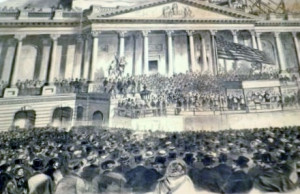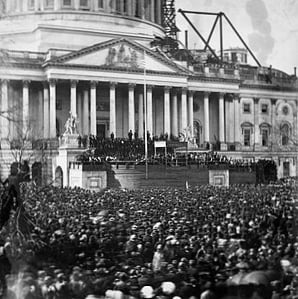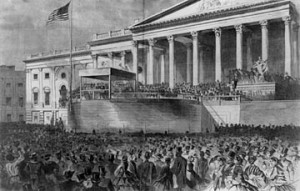Lincoln and the errant flag

A previous article about American flags and Inauguration Days through the decades described how presidential ceremonies have often featured multiple banners and plenty of bunting to decorate the special day.
An example in that article was Abraham Lincoln’s second inaugural address in 1865. His short, 700-word speech is renowned for his offer of reconciliation toward the defeated southern states. “With malice toward none, with charity for all, with firmness in the right as God gives us to see the right,” he intoned, “let us strive on to finish the work we are in, to bind up the nation’s wounds…and cherish a just and lasting peace among ourselves and with all nations.”

Four years earlier, when the Civil War was on the brink of exploding, Lincoln spoke at the Capitol with only a solo banner flapped wildly above him. But that flag almost disappeared before the new chief executive had said a word.
As The New York Times described it in March 1861, “Early in the forenoon, when the flag was unfurled upon the Capitol, one of the halyards gave way, and, splitting in two, the flag flung out like a pennant.”
The sight of the loosened flag was undoubtedly going to be taken as a divine sign of the tearing apart of the Union and the coming War Between the States. Perhaps it would have even been seen as a prophecy of the North’s defeat.

Something had to be done to rescue the flag and restore it to its rightful place. “For a long while,” The Times continued, the banner “could not be taken down.” That might have been due to the windy conditions of the day or the difficulty of shinnying up the flagpole to retrieve the errant rope.
But, the newspaper continued, “finally an adventurous man climbed to the top of the staff.” Once the anonymous hero reached the pole’s peak, he tore away “the ill-omened standard” and “replaced it with an entire flag of the Union.”
For the time being, short as it was, the Union was intact, the halyard was strong and the American flag was restored.
